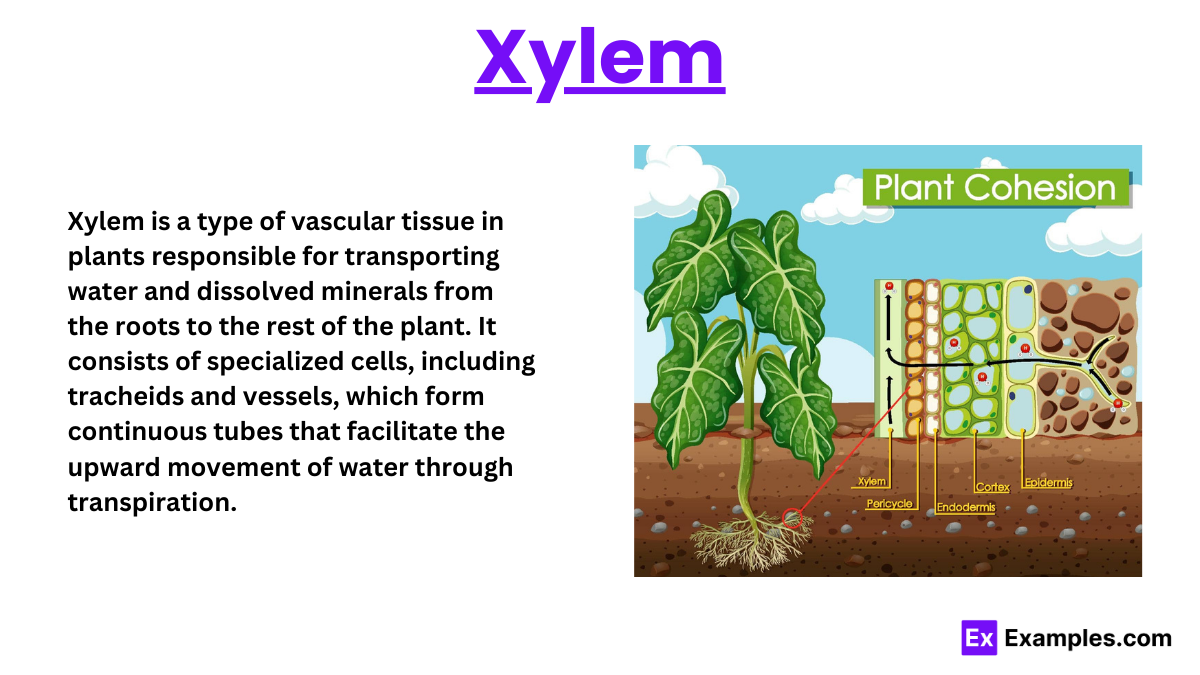What is the primary function of xylem in plants?
Transport of nutrients
Transport of water and minerals
Photosynthesis
Storage of food

Xylem is a crucial plant tissue that serves as the main conduit for transporting water and minerals from roots to all parts of a plant. This vital system not only hydrates the plant but also provides essential physical support. Found in all vascular plants, xylem is a complex network that includes tracheary elements, specialized cells dedicated to efficient water conduction. Alongside phloem, which carries sugars, xylem is a key component of the plant’s vascular system, present in a wide range of plants from ferns to flowering species.
Xylem is a crucial tissue in plants, akin to a lifeline, as it’s responsible for the upward movement of water and minerals from the roots to the rest of the plant. Much like blood vessels in animals that transport oxygen and nutrients, xylem ensures that water and essential mineral nutrients reach every part of the plant, enabling not just growth but also providing structural support.

Consider a mature oak tree: its xylem functions like a series of pipes, conducting water from the roots deep in the soil up through the trunk and branches to the leaves. This not only nourishes the tree but also allows it to maintain its towering structure. During spring, when the tree’s water needs increase to support new growth, the xylem’s role becomes even more critical, efficiently transporting water to the rapidly developing leaves and flowers.
Xylem formation begins with the differentiation of meristematic cells (cells that can divide and become various types of cells) in the plant’s vascular cambium (a layer of tissue that produces new vascular tissue). These cells elongate and undergo specialization to become either vessel elements or tracheids. During this process, the cells deposit lignin in their cell walls, which provides structural strength and water-proofing. Once mature, the cytoplasm in these cells degrades, leaving behind a hollow tube that is efficient for water transport. This continuous cycle of xylem cell development, maturation, and integration into the existing vascular system is essential for the plant’s growth and adaptation to its environment.
Xylem and phloem are vascular tissues in plants. Xylem transports water, phloem carries nutrients.
Xylem’s main function is to transport water and dissolved minerals from roots to other plant parts.
The four types of xylem are tracheids, vessels, xylem fibers, and xylem parenchyma.
Xylem is a plant tissue for water transport. Examples include the wood in trees.
Tree rings, visible in cut tree trunks, are a common example of xylem in plants.
Text prompt
Add Tone
10 Examples of Public speaking
20 Examples of Gas lighting
What is the primary function of xylem in plants?
Transport of nutrients
Transport of water and minerals
Photosynthesis
Storage of food
Which type of cells primarily make up the xylem?
Parenchyma cells
Sclerenchyma cells
Tracheids and vessel elements
Phloem fibers
How does water move through xylem vessels?
Active transport
Diffusion
Capillary action and transpiration pull
Bulk flow
What is the structure that allows xylem to withstand negative pressure during water transport?
Lignin
Cellulose
Chlorophyll
Starch
In which part of the plant is xylem found?
Only in the roots
In stems, roots, and leaves
Only in leaves
Only in flowers
What process drives the movement of water up through the xylem?
Photosynthesis
Root pressure
Transpiration
Osmosis
Which type of xylem cell is primarily responsible for water conduction in flowering plants?
Parenchyma
Sieve tube elements
Vessel elements
Guard cells
How does the xylem differ from phloem?
Xylem transports sugars; phloem transports water
Xylem is made of living cells; phloem is made of dead cells
Xylem transports water; phloem transports sugars
Xylem is found only in roots; phloem is found in leaves
What role do tracheids play in xylem function?
They store nutrients
They conduct water and provide support
They facilitate photosynthesis
They protect against pathogens
What happens to xylem cells as they mature?
They remain living
They become lignified and die
They divide continuously
They produce sugars
Before you leave, take our quick quiz to enhance your learning!

